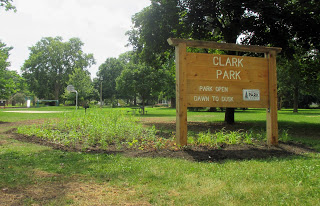
During my internship for Sea Grant I have been fortunate to not only learn about rain gardens but also be able to see one garden come to life. I saw the area beforehand, while the garden was built, and after the final flower was planted. I saw the change in the landscape. I sat under a tree just next to where the garden is today. I had the opportunity to speak with park experts to gain more insight in what it took to build the garden. But above all, I have been able to see the beauty of the garden as it grew.
The idea of planting a rain garden in Clark Park in Champaign began in September of 2014 when presented during a John Street watershed meeting. This led to a three-month-long period in which different designs were presented to the community. The final design was presented at a public meeting in February. Unfortunately the actual digging did not start until mid-June and the planting was not finished until July. This was due to excessive rain, ironically, and the maintenance of other park amenities such as pools, and tennis courts.
When I recently went to visit the garden, it was very rewarding to see how much it had grown. Even if I was not personally involved in making the garden a reality for this park, it was rewarding to see what can happen when there is a community willing to be involved as well as a park district willing to make this a reality. It didn’t matter that not all the flowers bloomed this season or that the flowers didn’t grow as much as they could have. I could see what the garden was bringing to the community. It was an environmentally conscious way of collecting water, attracted wildlife and added texture to the park.
 Shortly after it was planted I wondered how the garden was going to be able to grow. The seedling were small and fragile. Even with the rain that fell in July it still needed to be watered about every three days. What about children and pets who might trample them? But Horticulture and Natural Areas Supervisor Randy Hauser was not worried about this. Residents, in general, were careful of the garden. But that didn’t mean it was quarantined. People were welcome to interact with the garden even if the plants were very young.
Shortly after it was planted I wondered how the garden was going to be able to grow. The seedling were small and fragile. Even with the rain that fell in July it still needed to be watered about every three days. What about children and pets who might trample them? But Horticulture and Natural Areas Supervisor Randy Hauser was not worried about this. Residents, in general, were careful of the garden. But that didn’t mean it was quarantined. People were welcome to interact with the garden even if the plants were very young.

